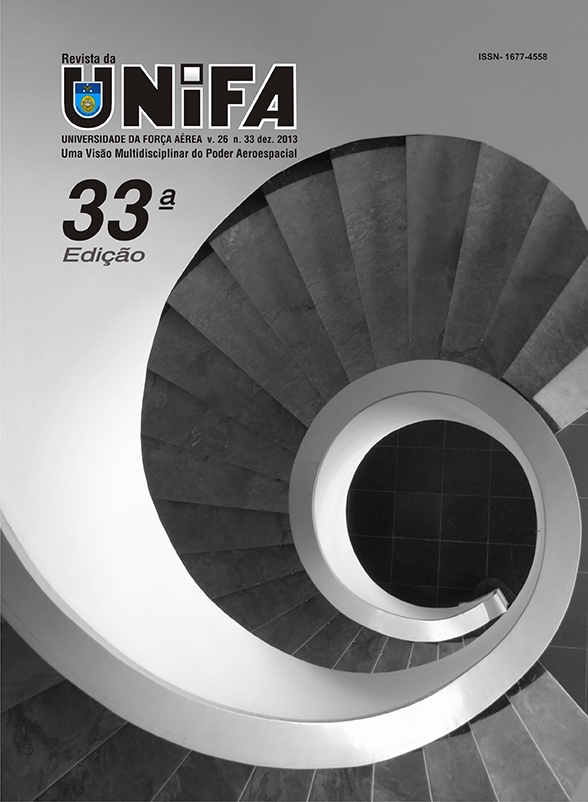Evaluation of space motion sickness among the flight trainees of the brazilian air force
DOI:
https://doi.org/10.22480/revunifa.2013.26.576Keywords:
Space motion sickness, Military personnel, Airsickness, PrevalenceAbstract
The objective of this research was to investigate the prevalence of motion sickness among aviation students of the Brazilian Air Force in Pirassununga, state of São Paulo, their search for medical treatment and the influence of symptoms on their performance. To this end, a cross-sectional prevalence study was conducted, based on a questionnaire created by the researcher. Then, the data were tabulated and analyzed confidentially. The number of cadets evaluated was 105. Their average age was 20 years, and the majority were male (97%). The small number of women does not allow inferring a comparison between the sexes. The number of individuals diagnosed with motion sickness was 46 (43.8%), while in international studies it ranges from 10% to 39%. Stunts were the most provocative maneuvers, cited by 28 of the 46 cadets. Of the 46 cadets affected, 45.6 (n=21) denied interference of symptoms in performance, 26.1% (n=12) reported that their performance was affected in one mission, 13% (n=6) in two missions, 4.4% (n=2) in three missions, 8.7% (n=4) in four or more missions and 2.2% (n=1) in all missions, corroborating previous studies of decreased performance caused by motion sickness. Of the cadets with symptoms of motion sickness, 58.7% (n=27) sought medical assistance after the crisis, but only 30.4% (n=14) underwent some type of treatment. Thus, a prevalence of motion sickness among Brazilian cadets was slightly higher than that found in international studies.
References
ACROMITE, M. et al. Operational applications of autogenic feedback training exercise as a treatment for airsickness in the military. In: WIML-NASA Workshop, 2011, Warsaw, Poland. [Anais…], Warsaw, Poland, 2011, p. 29.
ARMSTRONG, H. G. Aerospace medicine. Baltimore: Williams & Wilkins, 1961.
BAGSHAW, M. et al. The desensitisation of chronically motion sick aircrew in the Royal Air Force. Aviation, Space, and Environmental
Medicine, Alexandria, VA, USA. v. 56, n. 12, p. 1144, 1985.
BENSON, A. J.; STOTT, J. R. R. Motion Sickness. In: RAINFORD, D. J.; GRADWELL, D. P. (Ed). Ernsting`s aviation medicine. 4th ed. London:
Hodder Arnold, 2006.
BRASIL. Comando da Aeronáutica. Academia da Força Aérea. Currículo escolar: curso de formação de oficiais aviadores. Pirassununga, 2012.
BRASIL. Comando da Aeronáutica. Academia da Força Aérea. Manual de Procedimentos.Pirassununga, 2013.
BRASIL. Comando da Aeronáutica. Instruções específicas para o exame de admissão aos cursos de formação de oficiais aviadores,
intendentes e de infantaria da Aeronáutica do ano de 2011. Brasília, DF, 2010.
CEVETTE, M. J. et al. Oculo-vestibular recoupling using galvanic vestibular stimulation to mitigate simulator sickness. Aviation, Space, and
Environmental Medicine, Alexandria, VA, USA. v. 83, n. 6, p. 549-555, 2012.
GILES, D. A.; LOCHRIDGE, G. K. Behavioral airsickness management program for student pilots. Aviation, Space, and Environmental
Medicine, Alexandria, VA, USA. v. 56, n. 10, p. 991, 1985.
GORDON, C. R. et al. The effects of dimenhydrinate, cinnarizine and transdermal scopolamine on performance. Journal of Psychopharmacology, v. 15, n. 3, p. 167-172, 2001.
GRAYBIEL, A. et al. Diagnostic criteria for grading the severity of acute motion sickness. Aerosp Med, Washington, DC, v. 39, n. 5, maio
, p. 453-455.
LEVINS, T. T. Air sickness in flight: frequency and factors. Air Medical Journal, v. 22, n. 1, p. 26-27, 2003.
LUCERTINI, M.; LUGLI, V. The Italian Air Force rehabilitation programme for air-sickness. Acta Otorhinolaryngol Ital, v. 24, p. 181-187, 2004.
LUCERTINI, M. et al. Effects of airsickness in male and female student pilots: adaptation rates and 4-year outcomes. Aviation, Space, and
Environmental Medicine, Alexandria, VA, USA. v. 79, n. 7, p. 677-684, 2008.
MATSANGAS, P. The effect of mild motion sickness and sopite syndrome on multitasking cognitive performance. 2013. 120 f. Dissertação
(Doctor of philosophy in modeling, virtual environments, and simulation)-Naval Postgraduate School, Monterey, CA, 2013.
PARMET, A. J., ERCOLINE, W. R. Spacial orientation in flight. In: DAVIS, J. R. et al (Org.). Fundamentals of aerospace medicine. 4th ed.
Philadelphia: Wolters Kluwer; Lippincott; Williams & Wilkins, 2008.
PERSSON, R. Motion sickness in tilting trains: description and analysis of the present knowledge. Stockholm: VTI, 2008.
RASHEDIN, L. et al. Motion sickness in student pilots of Bangladesh Air Force Academy: a study of 80 cases. Sleep, v. 5, p. 25, 2009.
REBÊLO, K. F.; VIEIRA, D. F. C.; PINTO, R. M. N. Vertigem em aeronavegação. In: CALDAS, N.; DUPRAT, A. (Org.). Tratado de Otorrinolaringologia. São Paulo: Roca, 2003. v. 2, cap. 44, p. 486-495.
SCHMÄL, F. Neuronal mechanisms and treatment of motion sickness. Pharmacology, v. 91, n. 3-4, p. 229-241, 2013.
SHUPAK, A. GORDON, C. R. Motion sickness: advances in pathogenesis, prediction, prevention, and treatment. Aviation, Space, and
Environmental Medicine, Alexandria, VA, USA. v. 77, n. 12, p. 1213–1223, 2006.
Downloads
Published
Issue
Section
License
Copyright (c) 2013 Márcia Maria de Freitas Dias Voltolini

This work is licensed under a Creative Commons Attribution-NonCommercial 4.0 International License.
Revista da UNIFA permite que o (s) autor (es) mantenha(m) seus direitos autorais sem restrições. Atribuição-NãoComercial 4.0 Internacional (CC BY-NC 4.0) - Revista da UNIFA é regida pela licença CC-BY-NC









